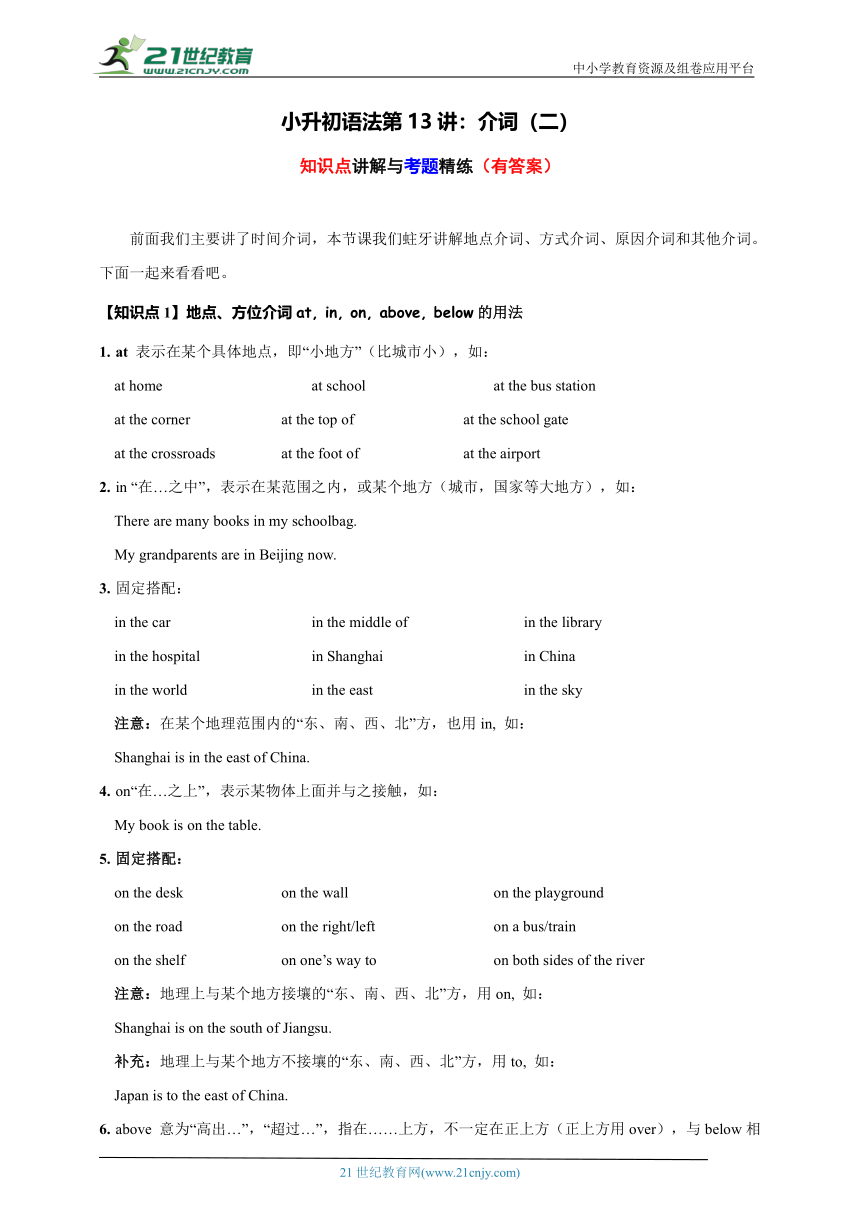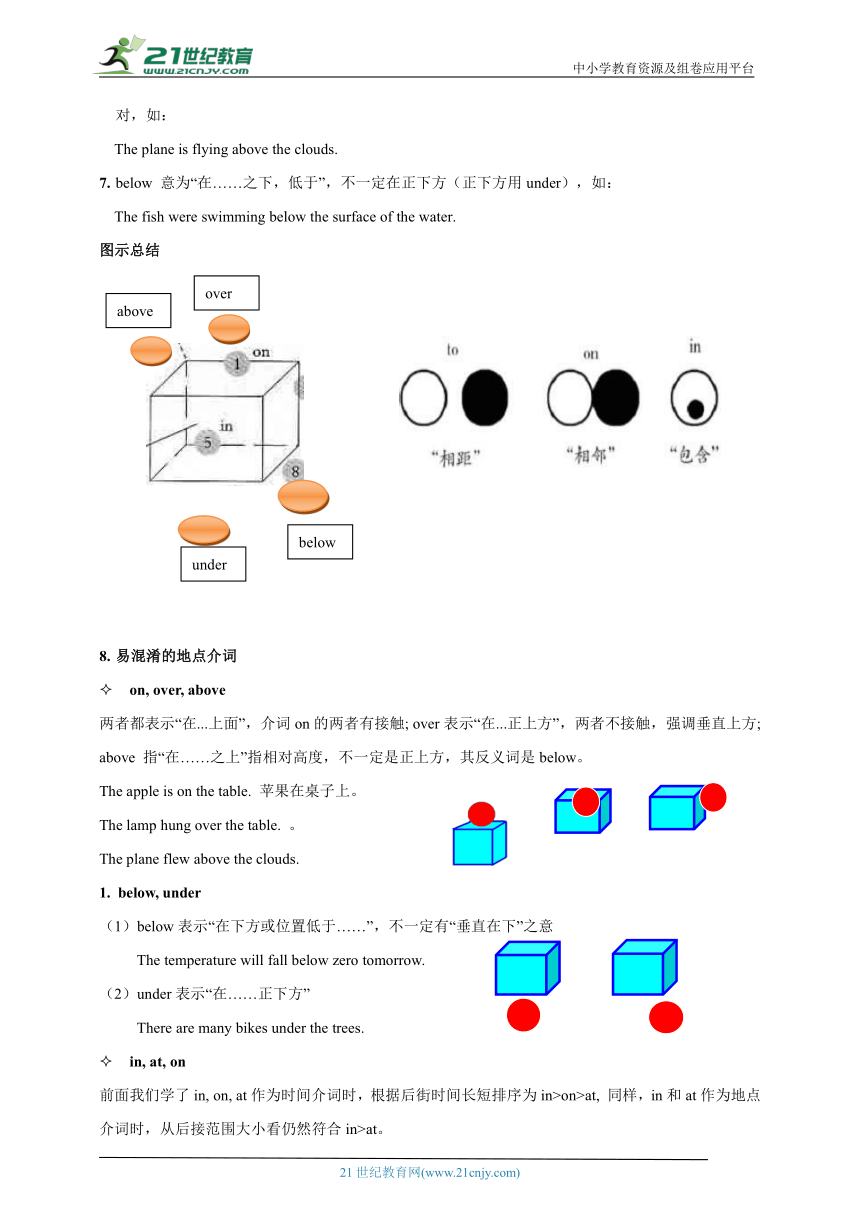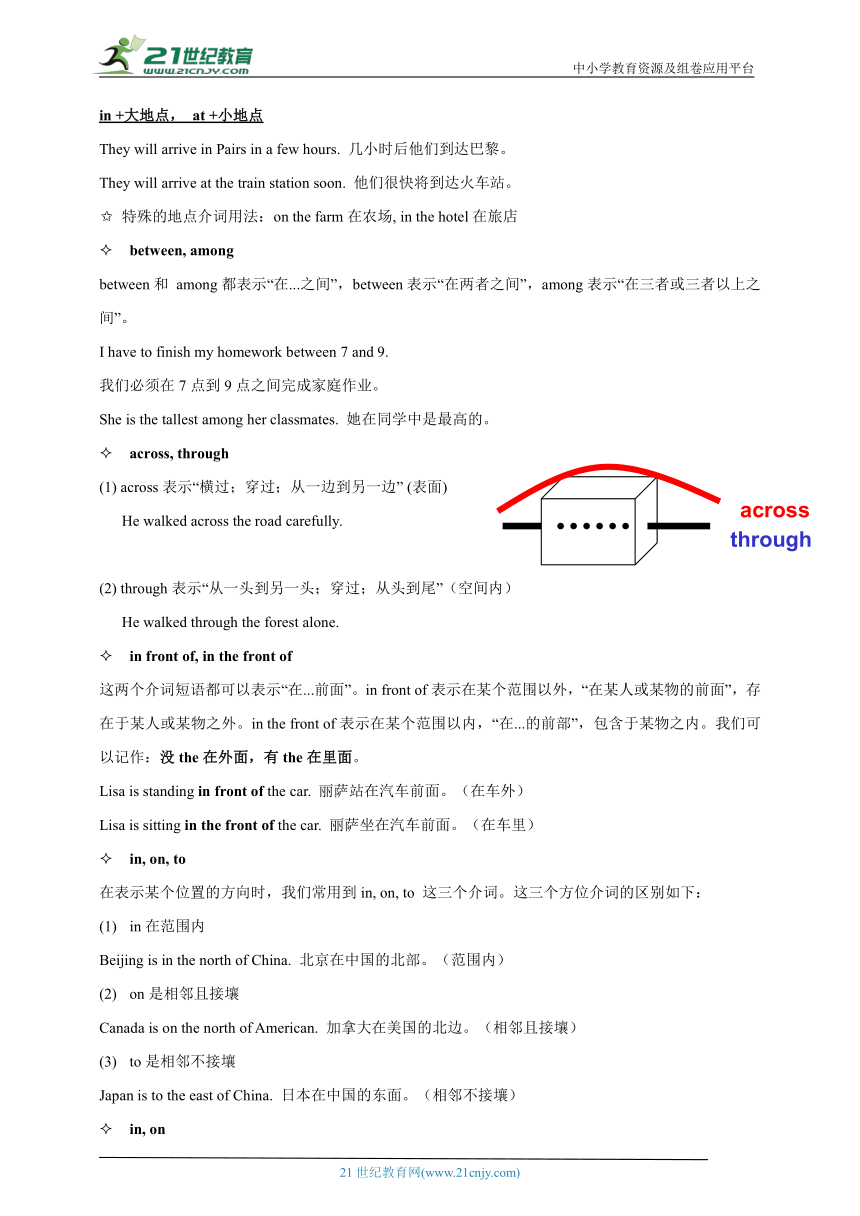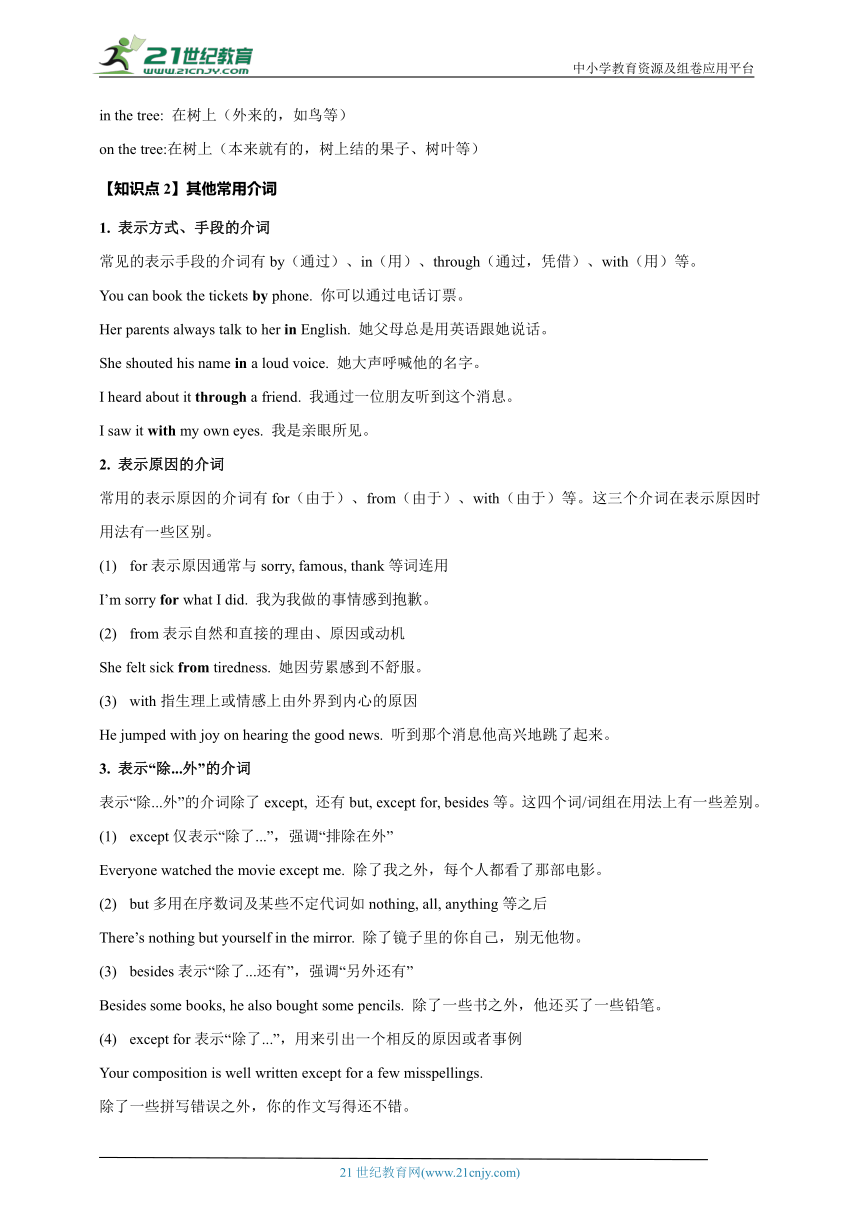【小升初语法】第13讲:介词(二)有答案
图片预览




文档简介
中小学教育资源及组卷应用平台
小升初语法第13讲:介词(二)
知识点讲解与考题精练(有答案)
前面我们主要讲了时间介词,本节课我们蛀牙讲解地点介词、方式介词、原因介词和其他介词。下面一起来看看吧。
【知识点1】地点、方位介词at, in, on, above, below的用法
at 表示在某个具体地点,即“小地方”(比城市小),如:
at home at school at the bus station
at the corner at the top of at the school gate
at the crossroads at the foot of at the airport
in “在…之中”,表示在某范围之内,或某个地方(城市,国家等大地方),如:
There are many books in my schoolbag.
My grandparents are in Beijing now.
固定搭配:
in the car in the middle of in the library
in the hospital in Shanghai in China
in the world in the east in the sky
注意:在某个地理范围内的“东、南、西、北”方,也用in, 如:
Shanghai is in the east of China.
on“在…之上”,表示某物体上面并与之接触,如:
My book is on the table.
固定搭配:
on the desk on the wall on the playground
on the road on the right/left on a bus/train
on the shelf on one’s way to on both sides of the river
注意:地理上与某个地方接壤的“东、南、西、北”方,用on, 如:
Shanghai is on the south of Jiangsu.
补充:地理上与某个地方不接壤的“东、南、西、北”方,用to, 如:
Japan is to the east of China.
above 意为“高出…”,“超过…”,指在……上方,不一定在正上方(正上方用over),与below相对,如:
The plane is flying above the clouds.
below 意为“在……之下,低于”,不一定在正下方(正下方用under),如:
The fish were swimming below the surface of the water.
图示总结
易混淆的地点介词
on, over, above
两者都表示“在...上面”,介词on的两者有接触; over表示“在...正上方”,两者不接触,强调垂直上方; above 指“在……之上”指相对高度,不一定是正上方,其反义词是below。
The apple is on the table. 苹果在桌子上。
The lamp hung over the table. 。
The plane flew above the clouds.
below, under
(1)below表示“在下方或位置低于……”,不一定有“垂直在下”之意
The temperature will fall below zero tomorrow.
(2)under表示“在……正下方”
There are many bikes under the trees.
in, at, on
前面我们学了in, on, at作为时间介词时,根据后街时间长短排序为in>on>at, 同样,in和at作为地点介词时,从后接范围大小看仍然符合in>at。
in +大地点, at +小地点
They will arrive in Pairs in a few hours. 几小时后他们到达巴黎。
They will arrive at the train station soon. 他们很快将到达火车站。
特殊的地点介词用法:on the farm在农场, in the hotel在旅店
between, among
between和 among都表示“在...之间”,between表示“在两者之间”,among表示“在三者或三者以上之间”。
I have to finish my homework between 7 and 9.
我们必须在7点到9点之间完成家庭作业。
She is the tallest among her classmates. 她在同学中是最高的。
across, through
(1) across表示“横过;穿过;从一边到另一边” (表面)
He walked across the road carefully.
(2) through表示“从一头到另一头;穿过;从头到尾”(空间内)
He walked through the forest alone.
in front of, in the front of
这两个介词短语都可以表示“在...前面”。in front of表示在某个范围以外,“在某人或某物的前面”,存在于某人或某物之外。in the front of表示在某个范围以内,“在...的前部”,包含于某物之内。我们可以记作:没the在外面,有the在里面。
Lisa is standing in front of the car. 丽萨站在汽车前面。(在车外)
Lisa is sitting in the front of the car. 丽萨坐在汽车前面。(在车里)
in, on, to
在表示某个位置的方向时,我们常用到in, on, to 这三个介词。这三个方位介词的区别如下:
in在范围内
Beijing is in the north of China. 北京在中国的北部。(范围内)
on是相邻且接壤
Canada is on the north of American. 加拿大在美国的北边。(相邻且接壤)
to是相邻不接壤
Japan is to the east of China. 日本在中国的东面。(相邻不接壤)
in, on
in the tree: 在树上(外来的,如鸟等)
on the tree:在树上(本来就有的,树上结的果子、树叶等)
【知识点2】其他常用介词
表示方式、手段的介词
常见的表示手段的介词有by(通过)、in(用)、through(通过,凭借)、with(用)等。
You can book the tickets by phone. 你可以通过电话订票。
Her parents always talk to her in English. 她父母总是用英语跟她说话。
She shouted his name in a loud voice. 她大声呼喊他的名字。
I heard about it through a friend. 我通过一位朋友听到这个消息。
I saw it with my own eyes. 我是亲眼所见。
表示原因的介词
常用的表示原因的介词有for(由于)、from(由于)、with(由于)等。这三个介词在表示原因时用法有一些区别。
for表示原因通常与sorry, famous, thank等词连用
I’m sorry for what I did. 我为我做的事情感到抱歉。
from表示自然和直接的理由、原因或动机
She felt sick from tiredness. 她因劳累感到不舒服。
with指生理上或情感上由外界到内心的原因
He jumped with joy on hearing the good news. 听到那个消息他高兴地跳了起来。
表示“除...外”的介词
表示“除...外”的介词除了except, 还有but, except for, besides等。这四个词/词组在用法上有一些差别。
except仅表示“除了...”,强调“排除在外”
Everyone watched the movie except me. 除了我之外,每个人都看了那部电影。
but多用在序数词及某些不定代词如nothing, all, anything等之后
There’s nothing but yourself in the mirror. 除了镜子里的你自己,别无他物。
besides表示“除了...还有”,强调“另外还有”
Besides some books, he also bought some pencils. 除了一些书之外,他还买了一些铅笔。
except for表示“除了...”,用来引出一个相反的原因或者事例
Your composition is well written except for a few misspellings.
除了一些拼写错误之外,你的作文写得还不错。
介词专项训练
一、单项选择。
( )1.He's very proud his father.
A.of B.with C.for
( )2.I always go for a walk with my grandfather dinner.
A.after B.by C.before
( )3.I'll be waiting your letter.
A.for B.of C.at
( )4.He was born September14th,1986.
A.at B.on C.in
( )5.--How did you go to school
-- bus.
A.Buy B.By C.On
( )6.Let's have a party you.
A.for B.to C.at
( )7.Is it Wednesday Thursday
A.or B.and C.with
( )8.How do you get the USA China
A.to;from B./form C.in;to
( )9.My birthday party will be 7 o'clock Sunday evening.
A.at;on B.in;on C.at;in
( )10.They play basketball fun Saturday.
A.on;for B.for;on C.for;in
( )11.In China,drivers drive the side of the road.
A.on;left B.on;right C.in;right
( )12.There is going to be a football match Class 1 Class2.
A.and;and B.in;and C.between;and
( )13.The students are learning the maple tree the Internet now.
A.with;in B.about;on C.to;at
( )14.I often clean my room Saturday.
A.in B.at C.on D./
( )15.I usually come to school .
A.by a bus B.on foot C.on feet D.on bus
( )16.For many western people,they drink cold water even winter.
A.on B.for C.at D.in
( )17.Taiwan is the southeast of China.
A.on B.in C.at D.by
( )18.Kate wants cabbage breakfast.
A.to eat;for B.eat;for C.to eat;o D.eat;on
( )19.Can you tell me something your school life
A.on B.about C.in D.with
( )20.Look!Lucy is a new red dress.She is beautiful today.
A.with B.put on C.in D.wear
( )21.A:What do you have dinner
B:I have rice and fish.
A.for;some B.for;a few C.with;some D.for;many
( )22.A red apple is the short tree,a small bird is the tall tree.
A.on;on B.in;in C.on;in D.in;on
( )23.--Is there a classroom building the school
--Yes,and there are some tall trees the classroom building.
A.in front of;in front of B.in the front of;in front of
C.in the front of;in the front of D.in front of;in the front of
参考答案
1.A 2.A 3.A 4.B 5.B 6.A 7.A 8.A 9.A 10.B 11.B 12.C 13.B 14.C 15.B 16.D 17.B 18.A 19.B 20.C 21.A 22.C 23.B
over
above
below
under
through
across
HYPERLINK "http://21世纪教育网(www.21cnjy.com)
" 21世纪教育网(www.21cnjy.com)
小升初语法第13讲:介词(二)
知识点讲解与考题精练(有答案)
前面我们主要讲了时间介词,本节课我们蛀牙讲解地点介词、方式介词、原因介词和其他介词。下面一起来看看吧。
【知识点1】地点、方位介词at, in, on, above, below的用法
at 表示在某个具体地点,即“小地方”(比城市小),如:
at home at school at the bus station
at the corner at the top of at the school gate
at the crossroads at the foot of at the airport
in “在…之中”,表示在某范围之内,或某个地方(城市,国家等大地方),如:
There are many books in my schoolbag.
My grandparents are in Beijing now.
固定搭配:
in the car in the middle of in the library
in the hospital in Shanghai in China
in the world in the east in the sky
注意:在某个地理范围内的“东、南、西、北”方,也用in, 如:
Shanghai is in the east of China.
on“在…之上”,表示某物体上面并与之接触,如:
My book is on the table.
固定搭配:
on the desk on the wall on the playground
on the road on the right/left on a bus/train
on the shelf on one’s way to on both sides of the river
注意:地理上与某个地方接壤的“东、南、西、北”方,用on, 如:
Shanghai is on the south of Jiangsu.
补充:地理上与某个地方不接壤的“东、南、西、北”方,用to, 如:
Japan is to the east of China.
above 意为“高出…”,“超过…”,指在……上方,不一定在正上方(正上方用over),与below相对,如:
The plane is flying above the clouds.
below 意为“在……之下,低于”,不一定在正下方(正下方用under),如:
The fish were swimming below the surface of the water.
图示总结
易混淆的地点介词
on, over, above
两者都表示“在...上面”,介词on的两者有接触; over表示“在...正上方”,两者不接触,强调垂直上方; above 指“在……之上”指相对高度,不一定是正上方,其反义词是below。
The apple is on the table. 苹果在桌子上。
The lamp hung over the table. 。
The plane flew above the clouds.
below, under
(1)below表示“在下方或位置低于……”,不一定有“垂直在下”之意
The temperature will fall below zero tomorrow.
(2)under表示“在……正下方”
There are many bikes under the trees.
in, at, on
前面我们学了in, on, at作为时间介词时,根据后街时间长短排序为in>on>at, 同样,in和at作为地点介词时,从后接范围大小看仍然符合in>at。
in +大地点, at +小地点
They will arrive in Pairs in a few hours. 几小时后他们到达巴黎。
They will arrive at the train station soon. 他们很快将到达火车站。
特殊的地点介词用法:on the farm在农场, in the hotel在旅店
between, among
between和 among都表示“在...之间”,between表示“在两者之间”,among表示“在三者或三者以上之间”。
I have to finish my homework between 7 and 9.
我们必须在7点到9点之间完成家庭作业。
She is the tallest among her classmates. 她在同学中是最高的。
across, through
(1) across表示“横过;穿过;从一边到另一边” (表面)
He walked across the road carefully.
(2) through表示“从一头到另一头;穿过;从头到尾”(空间内)
He walked through the forest alone.
in front of, in the front of
这两个介词短语都可以表示“在...前面”。in front of表示在某个范围以外,“在某人或某物的前面”,存在于某人或某物之外。in the front of表示在某个范围以内,“在...的前部”,包含于某物之内。我们可以记作:没the在外面,有the在里面。
Lisa is standing in front of the car. 丽萨站在汽车前面。(在车外)
Lisa is sitting in the front of the car. 丽萨坐在汽车前面。(在车里)
in, on, to
在表示某个位置的方向时,我们常用到in, on, to 这三个介词。这三个方位介词的区别如下:
in在范围内
Beijing is in the north of China. 北京在中国的北部。(范围内)
on是相邻且接壤
Canada is on the north of American. 加拿大在美国的北边。(相邻且接壤)
to是相邻不接壤
Japan is to the east of China. 日本在中国的东面。(相邻不接壤)
in, on
in the tree: 在树上(外来的,如鸟等)
on the tree:在树上(本来就有的,树上结的果子、树叶等)
【知识点2】其他常用介词
表示方式、手段的介词
常见的表示手段的介词有by(通过)、in(用)、through(通过,凭借)、with(用)等。
You can book the tickets by phone. 你可以通过电话订票。
Her parents always talk to her in English. 她父母总是用英语跟她说话。
She shouted his name in a loud voice. 她大声呼喊他的名字。
I heard about it through a friend. 我通过一位朋友听到这个消息。
I saw it with my own eyes. 我是亲眼所见。
表示原因的介词
常用的表示原因的介词有for(由于)、from(由于)、with(由于)等。这三个介词在表示原因时用法有一些区别。
for表示原因通常与sorry, famous, thank等词连用
I’m sorry for what I did. 我为我做的事情感到抱歉。
from表示自然和直接的理由、原因或动机
She felt sick from tiredness. 她因劳累感到不舒服。
with指生理上或情感上由外界到内心的原因
He jumped with joy on hearing the good news. 听到那个消息他高兴地跳了起来。
表示“除...外”的介词
表示“除...外”的介词除了except, 还有but, except for, besides等。这四个词/词组在用法上有一些差别。
except仅表示“除了...”,强调“排除在外”
Everyone watched the movie except me. 除了我之外,每个人都看了那部电影。
but多用在序数词及某些不定代词如nothing, all, anything等之后
There’s nothing but yourself in the mirror. 除了镜子里的你自己,别无他物。
besides表示“除了...还有”,强调“另外还有”
Besides some books, he also bought some pencils. 除了一些书之外,他还买了一些铅笔。
except for表示“除了...”,用来引出一个相反的原因或者事例
Your composition is well written except for a few misspellings.
除了一些拼写错误之外,你的作文写得还不错。
介词专项训练
一、单项选择。
( )1.He's very proud his father.
A.of B.with C.for
( )2.I always go for a walk with my grandfather dinner.
A.after B.by C.before
( )3.I'll be waiting your letter.
A.for B.of C.at
( )4.He was born September14th,1986.
A.at B.on C.in
( )5.--How did you go to school
-- bus.
A.Buy B.By C.On
( )6.Let's have a party you.
A.for B.to C.at
( )7.Is it Wednesday Thursday
A.or B.and C.with
( )8.How do you get the USA China
A.to;from B./form C.in;to
( )9.My birthday party will be 7 o'clock Sunday evening.
A.at;on B.in;on C.at;in
( )10.They play basketball fun Saturday.
A.on;for B.for;on C.for;in
( )11.In China,drivers drive the side of the road.
A.on;left B.on;right C.in;right
( )12.There is going to be a football match Class 1 Class2.
A.and;and B.in;and C.between;and
( )13.The students are learning the maple tree the Internet now.
A.with;in B.about;on C.to;at
( )14.I often clean my room Saturday.
A.in B.at C.on D./
( )15.I usually come to school .
A.by a bus B.on foot C.on feet D.on bus
( )16.For many western people,they drink cold water even winter.
A.on B.for C.at D.in
( )17.Taiwan is the southeast of China.
A.on B.in C.at D.by
( )18.Kate wants cabbage breakfast.
A.to eat;for B.eat;for C.to eat;o D.eat;on
( )19.Can you tell me something your school life
A.on B.about C.in D.with
( )20.Look!Lucy is a new red dress.She is beautiful today.
A.with B.put on C.in D.wear
( )21.A:What do you have dinner
B:I have rice and fish.
A.for;some B.for;a few C.with;some D.for;many
( )22.A red apple is the short tree,a small bird is the tall tree.
A.on;on B.in;in C.on;in D.in;on
( )23.--Is there a classroom building the school
--Yes,and there are some tall trees the classroom building.
A.in front of;in front of B.in the front of;in front of
C.in the front of;in the front of D.in front of;in the front of
参考答案
1.A 2.A 3.A 4.B 5.B 6.A 7.A 8.A 9.A 10.B 11.B 12.C 13.B 14.C 15.B 16.D 17.B 18.A 19.B 20.C 21.A 22.C 23.B
over
above
below
under
through
across
HYPERLINK "http://21世纪教育网(www.21cnjy.com)
" 21世纪教育网(www.21cnjy.com)
